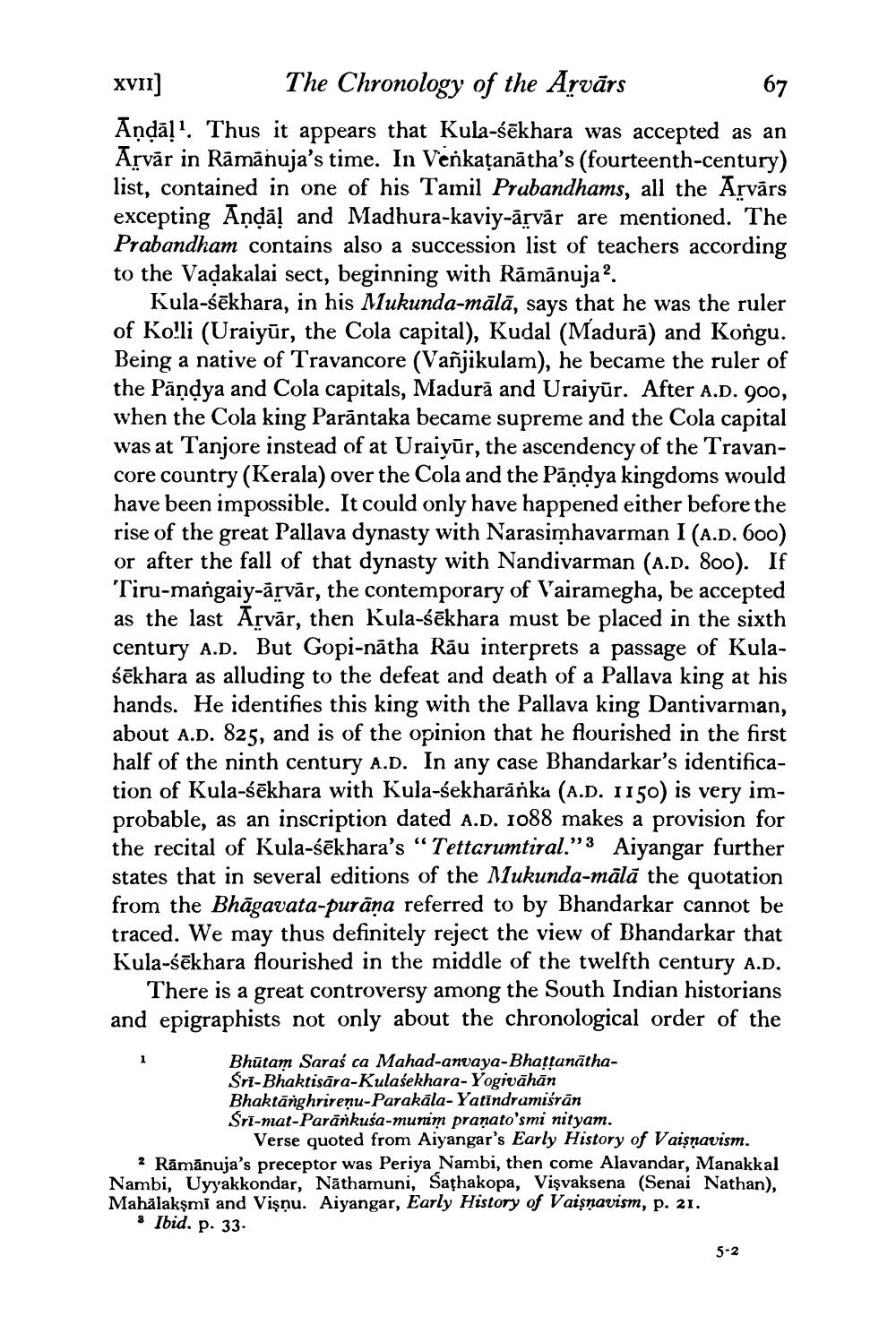________________
XVII] The Chronology of the Arvārs Andā!". Thus it appears that Kula-śēkhara was accepted as an Arvār in Rāmānuja's time. In Verkațanātha's (fourteenth-century) list, contained in one of his Tamil Prubandhams, all the Arvārs excepting Andāļ and Madhura-kaviy-ārvār are mentioned. The Prabandham contains also a succession list of teachers according to the Vadakalai sect, beginning with Rāmānuja?
Kula-śēkhara, in his Mukunda-mālā, says that he was the ruler of Kolli (Uraiyūr, the Cola capital), Kudal (Madurā) and Kongu. Being a native of Travancore (Vañjikulam), he became the ruler of the Pandya and Cola capitals, Madurā and Uraiyūr. After A.D. 900, when the Cola king Parāntaka became supreme and the Cola capital was at Tanjore instead of at Uraiyūr, the ascendency of the Travancore country (Kerala) over the Cola and the Pandya kingdoms would have been impossible. It could only have happened either before the rise of the great Pallava dynasty with Narasimhavarman I (A.D. 600) or after the fall of that dynasty with Nandivarman (A.D. 800). If Tiru-mangaiy-ārvār, the contemporary of Vairamegha, be accepted as the last Arvār, then Kula-śēkhara must be placed in the sixth century A.D. But Gopi-nātha Rău interprets a passage of Kulaśēkhara as alluding to the defeat and death of a Pallava king at his hands. He identifies this king with the Pallava king Dantivarman, about A.D. 825, and is of the opinion that he flourished in the first half of the ninth century A.D. In any case Bhandarkar's identification of Kula-śēkhara with Kula-sekharānka (A.D. 1150) is very improbable, as an inscription dated A.D. 1088 makes a provision for the recital of Kula-śēkhara's “Tettarumtiral.”3 Aiyangar further states that in several editions of the Mukunda-mālā the quotation from the Bhāgavata-purāna referred to by Bhandarkar cannot be traced. We may thus definitely reject the view of Bhandarkar that Kula-śēkhara flourished in the middle of the twelfth century A.D.
There is a great controversy among the South Indian historians and epigraphists not only about the chronological order of the
Bhūtam Saraś ca Mahad-anvaya-BhatsunāthaSri-Bhaktisāra-Kulasekhara-Yogivāhān Bhaktānghrirenu-Parakāla-Yatīndrumistān Sri-mat-Paränkuśa-munim pranato'smi nityam.
Verse quoted from Aiyangar's Early History of Vaisnavism. 2 Rāmānuja's preceptor was Periya Nambi, then come Alavandar, Manakkal Nambi, Uyyakkondar, Nāthamuni, Sathakopa, Vişvaksena (Senai Nathan), Mahālakṣmi and Vişnu. Aiyangar, Early History of Vaişnavism, p. 21. 8 Ibid. p. 33.
5-2




